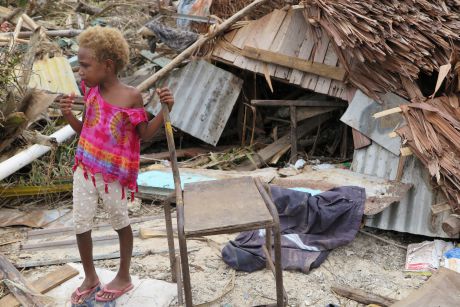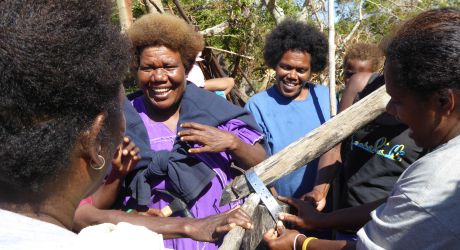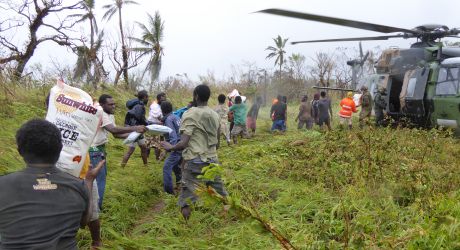Project Overview
The Saving Lives in Vanuatu project is helping poor communities in Vanuatu better prepare for, and recover from, natural disasters and weather events. Vanuatu is one of the world’s most susceptible countries to natural disasters, making this project essential to the lives of participating communities. This was further demonstrated when Cyclone Pam struck the country in March 2015, causing widespread damage.
In 2016, 7,824 people benefited from this project. Care established and supported 13 Community Response and Action Plans on the islands of Tanna and Anietyum in Tafea Province.
Care also supported the Provincial and National Disaster Offices of Vanuatu to help improve their disaster management and emergency response planning.

Key Project Activities
Community Disaster and Climate Change
Community Disaster and Climate Change Committees bring communities together in the event of a natural disaster and feed valuable information up to the Provincial Disaster and Climate Change Committee to coordinate and streamline responses in an emergency.
In this reporting period, 13 committees were established. Committee members were trained in how to prepare for disasters, how to assess initial damage, and how to adapt to climate change, such as through planting flood-resistant seeds and learning safer building techniques.
All groups took part in an emergency simulation exercise where all members could practice and test their skills in real-time. For each committee, the roles and responsibilities of those responding to an emergency are now clearly defined.
Feedback from those who participated was positive, and most now feel confident and understand their role in an emergency response.

Including Women in Disaster Response Plans
Up to 50 per cent of committee members are women. Women have taken on roles as Coordinators, Team Leaders, Communications Managers and Disaster and Activity Relief Managers. During a disaster, women face a unique set of needs, since they are usually responsible for the care of children and the elderly, and face disadvantages in physical strength. Beyond immediate survival, women in disaster zones also face long-term challenges such as missing out on emergency relief, since they are often confined to private spaces caring for the young and the elderly, and lack of health services including for pregnancy and child birth. Involving women in response plans is an essential part of community emergency preparedness activities.
In the communities of Tanna and Aneityum, women face additional cultural barriers to taking up community leadership roles. For example, women are often expected to take care of their families as well as earn an income, particularly during busy tourism periods, leaving little time for leadership roles in the wider community. Women also generally have lower levels of education compared to men, and this can undermine their confidence to speak out and to act with authority. Concerted efforts therefore must be made to ensure women are involved in disaster preparedness in communities in Vanuatu.
Through continued discussion with and training of communities on the importance of including women in leadership and decision-making, CARE will continue to promote and support women into leadership roles and contribute to Council Development Plans to ensure guidelines include the needs of women and girls, men and boys in an emergency response.
Community Response and Action Plans
To date, 11 of the 13 communities have completed their community response and action plans. These plans make residents aware of the safest place to find shelter, and teach residents to minimise damage to their livelihoods property and own lives through simple measures such as removing trees from overhanging their homes or growing flood resistant crops. Once plans are complete, local area councils will incorporate Community Response and Action Plans into their own Development Plans.

What Next?
An impact study of CARE’s disaster preparedness was done to measure the actions and responses of those communities who have taken part in this project. Findings from the study found that communities who had received information from this project and developed strong relationships with their Provincial Disaster Committee, particularly prior to Tropical Cyclone Pam, realised sustainable improvements in their ability to plan, prepare and manage risks.
Findings from this report show that disaster risk management is effective for saving lives during a disaster, and will be used to secure future support and funding for this project.
Can I visit this project?
Due to the nature of this project, not at this time.
Project ObjectivesThe aim of the YUMI Strong project is to identify the needs and priorities of small, remote and vulnerable island communities and to support over 12,474 people to develop stronger infrastructure and systems aimed at protecting lives in the event of natural disasters such as cyclones, floods, drought and earthquakes. The project will contribute to improving the food, water and economic security of 14 remote island communities hit the hardest by Cyclone Pam. Outcomes of the project will ensure communities and governments on these islands are able to;
- Protect lives during a natural disaster.
- Recover sooner after a natural disaster.
- Develop disaster management and response plans, including identifying people with disabilities and the elderly.
- Grow disease, flood and drought resistant food crops, such as taro and sweet potato to ensure a constant and secure food supply.
- Care for animals and livestock.
- Build and maintain disaster resistant water supplies such as tanks and wells.
- Build stronger homes and protect and strengthen existing homes.
- Receive, measure and interpret meteorological information such as change in weather patterns and rainfall
- Increase the involvement of women in leading communities to respond to disasters.
- Develop policy and practices that increase a community’s resilience to changing climate and natural disasters.
|
Project Activities
Funding towards the YUMI strong project will allow for:
- Development of community and area council response and action plans
- School awareness sessions
- Community disaster risk management training and emergency simulations
- First aid training and provision of first aid kits
- Water, soil, pest and climate change management training
- Training and supply of agricultural methods and materials to communities, schools and households
- Water, Sanitation and Hygiene materials such as water catchment systems and toilets
- Youth-led climate change events
- Provincial and National level resilience training, workshops and forums
Background on the current situation
|
Vanuatu is noted by the United Nations as being the country most vulnerable to natural disasters. Climate forecasting predicts dry seasons will become drier and wet seasons wetter. We expect to see temperatures climb, stronger cyclones, an increase in ocean acidification, and rising sea levels. On the remote islands of Vanuatu, infrastructure such as housing, energy and water is extremely basic and families are reliant on small-scale farming and fishing. In times of natural disaster, basic infrastructure and farming crops are extremely vulnerable and likely to be damaged; Disasters impact almost all aspects of life for people living on the 83 islands that make up Vanuatu. While there is political commitment to accept Disaster Risk Management as a developmental issue, the Government of Vanuatu remains underesourced and lacks capacity to implement and coordinate activities across the many small Islands.
Investing in resilience is cost effective when compared with approaches that rely exclusively on response and recovery by one to seven dollars. Project Partners
|
CARE ensures the project is sustainable by engaging entire communities and works with implementing partners including local schools, councils, national government and other NGOs, including:
- Vanuatu Disaster Management Office
- Department of Agriculture and Rural Development
- Vanuatu Meteorological and Geohazards Department
- Provincial Disaster Committee
- Rural Water Supply
- French Red Cross
|
|
|
|